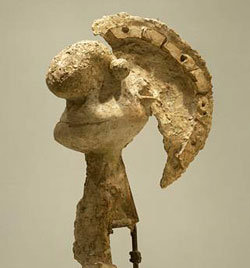Picasso Sculpture
dal 2/7/2008 al 2/11/2008
Segnalato da
The Museum of Modern Art - MoMa
2/7/2008
Picasso Sculpture
The Museum of Modern Art - MoMA, New York
Focus. The artist turned to sculpture with particular rigor at several key moments in his career, using the medium as a testing ground for ideas that would catalyze crucial shifts in his practice at large. Picasso introduced non-art materials into his artwork, radically incorporating everyday objects into his sculpture much as he used found print materials in his famous collage works. The transformation from banal item to sculptural element is never complete, and much of the great visual wit of the objects seen here comes from the play between these two roles.

Organized by Leah Dickerman, Curator, with Nora Lawrence, Curatorial Assistant, Department of Painting and Sculpture.
Pablo Picasso is perhaps best known for his paintings, but his sculptures are among the most radical, thought-changing artworks of the modern period. While the artist's two-dimensional work was frequently exhibited during his lifetime, the first comprehensive exhibition of Picasso's sculpture was mounted in 1966, when the artist was eighty-five years old. This installation provides a broad overview of the artist's career as a creator of three-dimensional objects through selections from The Museum of Modern Art's collection. The strength of the Museum's collection in this area is due, in part, to the support it received from the artist himself, who donated his sheet-metal construction Guitar (1914), on view here, to the Museum in 1971.
Picasso turned to sculpture with particular rigor at several key moments in his career, using the medium as a testing ground for ideas that would catalyze crucial shifts in his practice at large. The sculpture Woman's Head (Fernande) (1909), also on view, helped Picasso conceptualize the break of solid volume into shifting masses suggestive of varying perspectives, and served as a foundation for the development of Cubism. In much of his subsequent sculptural work, Picasso abandoned the traditional art of modeling in favor of assemblage and construction. Picasso introduced non-art materials into his artwork, radically incorporating everyday objects into his sculpture much as he used found print materials in his famous collage works. The transformation from banal item to sculptural element is never complete, and much of the great visual wit of the objects seen here comes from the play between these two roles.
This exhibition, part of an ongoing series highlighting noteworthy aspects of the Museum's collection, is made possible by BNP Paribas.
Upcoming related events:
Thursday, July 10, 2008
1:30 p.m.
Lectures & Gallery Talks | Gallery Talks
Focus: Picasso Sculpture
With Deborah Goldberg
Thursday, July 31, 2008
1:30 p.m.
Lectures & Gallery Talks | Gallery Talks
Focus: Picasso Sculpture
With Nuit Banai
The Museum of Modern Art - MoMa
11 West 53 Street - New York



